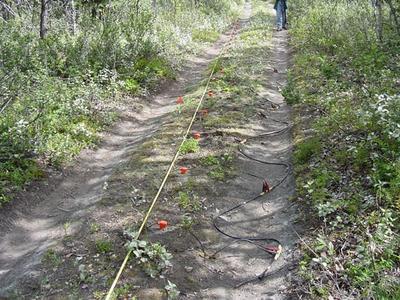22 July, 2002
Greetings........
Bob Bigl bored the hole today that I will use for my project. It is located
on a relatively flat portion of the glacier that will allow for fairly easy
use of ground penetrating radar. Dr. Baker and I plan to head back up on
the glacier later tonight to see if the drilling equipment has been moved.
If so, we will head up on the glacier first thing in the morning and do some
testing with GPR and the weights to determine how best to proceed. If the
drill equipment hasnıt been moved, then we will collect some GPR data on a
site that Kendra has been working on to image the top of buried ice.
Today I went out with Dr. Baker, Kendra, and Darren (a REU student) to
collect some seismic data. This is a continuation of work that has been
ongoing for several years. Dr. Baker is attempting to find the depth to
bedrock beneath glacial outwash debris. We ran two separate lines about
300m long each at two separate locations. This data will help reveal how
the depth to bedrock varies throughout the Matanuska River valley.
Seismic data is collected by measuring the time it takes for energy (similar
to sound waves) to travel underground and bounce or ³reflect² off of
boundaries in the subsurface. Once the energy reflects, it returns to the
surface where it is recorded using instruments known as geophones which are
firmly planted into the ground on metal spikes. Seismic energy can be
generated many different ways, but we made ours today by sharply and
repetedly striking a sledge hammer against an aluminum plate that is seated
into the ground. The location of the generated wave (known at the ³shot
location²) is then moved along the set line when the plate is struck again.
This process continues along the entire length of the line. We were using
12-m intervals between shot locations.
The geophones collect data by generating an electrical charge when the
vibration from the wave (or any other source) reaches them. Several times
today we had to wait for airplanes to pass so the the noise from them didnıt
interfere with our data collection. Inside the geophone is a coil of wire
suspended on springs. Inside of the coil is a magnet. When the wave
reaches the geophone the magnet moves up and down relative to the wire
creating the current that is recorded and ultimately used to determine what
types of materials are beneath the surface.
Another glorious day on the Matanuska.......
Life is Good,
DT

Line of geophones used to gather seismic data.

Dr. Baker collecting seismic data in the Matanuska River valley.

Bob Bigl from CRREL lokking over data collected during drilling.

Bob Bigl from CRREL sets up the drill rig for boring a hole in the ice. All of the equipment is carried on sleds and transported by ATV.
Contact the TEA in the field at
.
If you cannot connect through your browser, copy the
TEA's e-mail address in the "To:" line of
your favorite e-mail package.
|
